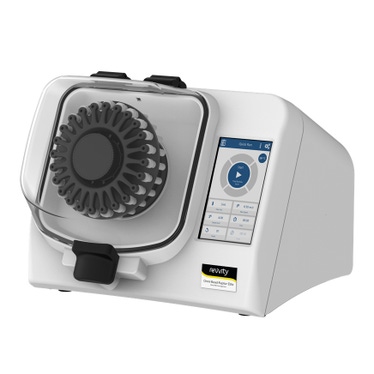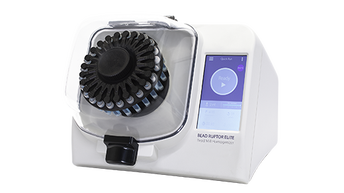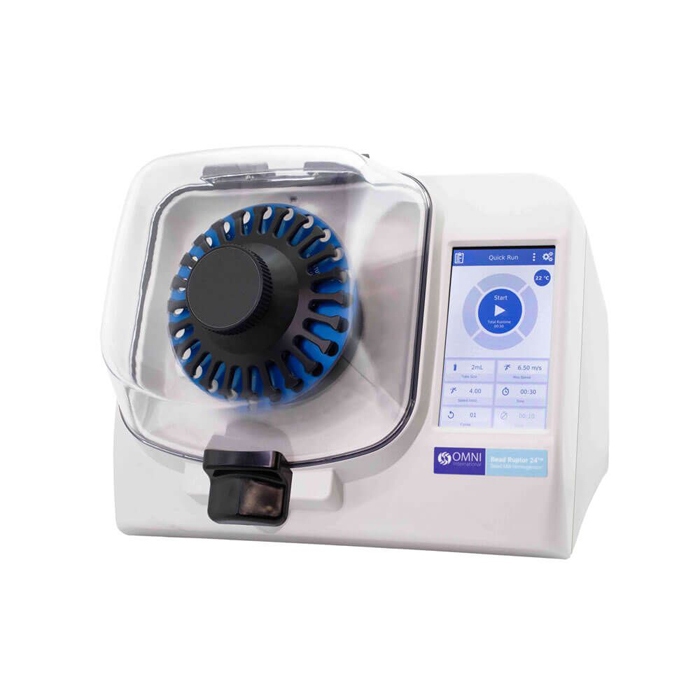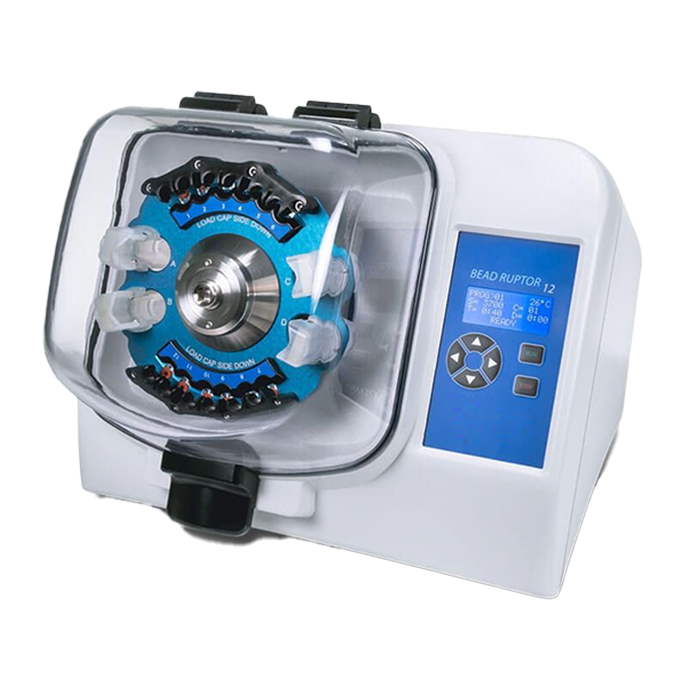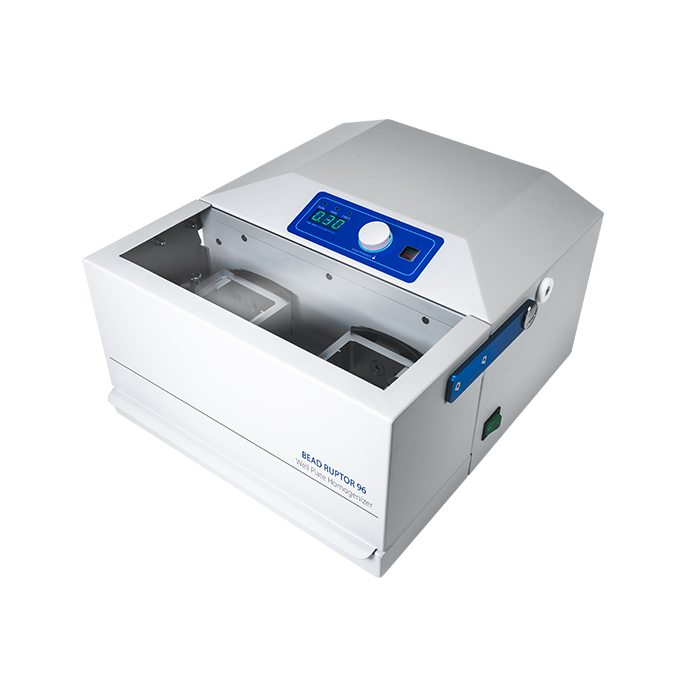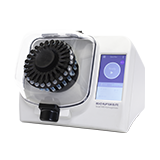
Omni Bead Ruptor Elite bead mill homogenizer
The Omni Bead Ruptor Elite bead mill homogenizer is a reliable workhorse for any labs seeking consistency in their sample prep, starting with sample homogenization and tissue disaggregation. It combines the benefits of power, efficiency, and flexibility in grinding, lysing, and homogenizing tough samples or complex matrices in various tube type formats for a diverse range of downstream -omics applications.
The Omni Bead Ruptor Elite bead mill homogenizer is a reliable workhorse for any labs seeking consistency in their sample prep, starting with sample homogenization and tissue disaggregation. It combines the benefits of power, efficiency, and flexibility in grinding, lysing, and homogenizing tough samples or complex matrices in various tube type formats for a diverse range of downstream -omics applications.
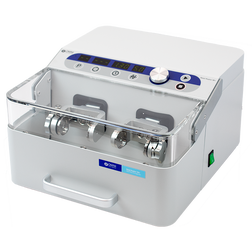
Omni Bead Ruptor 96+ well-plate homogenizer
The Omni Bead Ruptor 96+ well-plate homogenizer is a high-throughput, tabletop bead mill homogenizer that is also compatible with jar-milling, cryogenic milling, and tube bead-beating. The all-in-one unit is a versatile solution for labs looking for a multi-purpose homogenizer for diverse sample applications, not limited to particle size reduction, disaggregation of non-biological and biological samples, and cryo-milling. It has high-throughput capabilities by its ability to efficiently homogenize and process stacks of standard well plates or racks of strip well tubes during processing using its unique well plate adapter system.
The Omni Bead Ruptor 96+ well-plate homogenizer is a high-throughput, tabletop bead mill homogenizer that is also compatible with jar-milling, cryogenic milling, and tube bead-beating. The all-in-one unit is a versatile solution for labs looking for a multi-purpose homogenizer for diverse sample applications, not limited to particle size reduction, disaggregation of non-biological and biological samples, and cryo-milling. It has high-throughput capabilities by its ability to efficiently homogenize and process stacks of standard well plates or racks of strip well tubes during processing using its unique well plate adapter system.

Omni Bead Ruptor 12 bead mill homogenizer
The Omni Bead Ruptor 12 bead mill homogenizer is uniquely designed for low- to medium-throughput labs who are looking for efficiency while being cost conscious. The unit accommodates up to 12 samples per run when using 2mL tubes; it is also compatible with processing up to 4 samples in 7mL tubes at a time. This tabletop homogenizer will help streamline sample homogenization workflows across multiple lab users, all at an attractive price point.
The Omni Bead Ruptor 12 bead mill homogenizer is uniquely designed for low- to medium-throughput labs who are looking for efficiency while being cost conscious. The unit accommodates up to 12 samples per run when using 2mL tubes; it is also compatible with processing up to 4 samples in 7mL tubes at a time. This tabletop homogenizer will help streamline sample homogenization workflows across multiple lab users, all at an attractive price point.
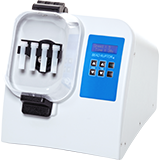
Omni Bead Ruptor 4 bead mill homogenizer
The Omni Bead Ruptor 4 bead mill homogenizer is our entry-level bead mill homogenizer, offering a quick and simple solution for cost-conscious labs looking to leverage automation-enabled sample homogenization but doesn’t require anything more than a few tubes at a time. It is a popular unit for labs that are starting their transition from more manual methods to automation-enabled bead mill homogenization to increase their workflow efficiency as lab needs develop and throughput increases. This compact unit is capable of processing up to four tubes, for sample volumes starting at 25 µL.
The Omni Bead Ruptor 4 bead mill homogenizer is our entry-level bead mill homogenizer, offering a quick and simple solution for cost-conscious labs looking to leverage automation-enabled sample homogenization but doesn’t require anything more than a few tubes at a time. It is a popular unit for labs that are starting their transition from more manual methods to automation-enabled bead mill homogenization to increase their workflow efficiency as lab needs develop and throughput increases. This compact unit is capable of processing up to four tubes, for sample volumes starting at 25 µL.
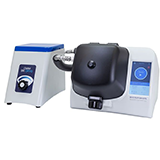
Omni Bead Ruptor cryo cooling unit
The Omni Bead Ruptor cryo cooling unit helps protect heat-sensitive samples during homogenization by maintaining a constant processing temperature and countering the heat generated as part of the bead-milling process. The unit is compatible with the Omni Bead Ruptor Elite bead mill homogenizer and operates by passing chilled air into the processing chamber to dissipate heat from across the sample tubes, better protecting heat-sensitive analytes for downstream processing. It has adjustable cooling rates and is compatible with both liquid nitrogen (preferred method) or dry ice with ethanol. In conjunction with the homogenizer, the unit is compatible with carriages that accommodate tube sizes < 7 mL, but not compatible with the 48 position 2mL carriage system.
The Omni Bead Ruptor cryo cooling unit helps protect heat-sensitive samples during homogenization by maintaining a constant processing temperature and countering the heat generated as part of the bead-milling process. The unit is compatible with the Omni Bead Ruptor Elite bead mill homogenizer and operates by passing chilled air into the processing chamber to dissipate heat from across the sample tubes, better protecting heat-sensitive analytes for downstream processing. It has adjustable cooling rates and is compatible with both liquid nitrogen (preferred method) or dry ice with ethanol. In conjunction with the homogenizer, the unit is compatible with carriages that accommodate tube sizes < 7 mL, but not compatible with the 48 position 2mL carriage system.
We offer the Omni Bead Ruptor Elite™ bead mill homogenizers – compatible with our BR Cryo-cooling unit to help with temperature-sensitive analytes such as RNA - for labs looking for ultimate flexible in throughput and tube size compatibility, the Omni Bead Ruptor 96 well-plate homogenizer for those looking to implement bead milling technology into their laboratory workflows that use well-plate systems or larger milling jars, and the lower throughput but just as reliable Omni Bead Ruptor 12 and 4 for labs starting out on their journey with automation-enabled sample homogenization.
Explore our Bead Mill accessories, including Omni Bead Ruptor Elite accessories or Omni Bead Ruptor 96 accessories.
We also offer bead mill consumables and bulk tubes, caps, and well-plates.
Explore our solutions
Featured resources
References:
- Amanda M Jones, Marshall T Van de Wyngaerde, Erika T Machtinger, Edwin G Rajotte, Thomas C Baker, Choice of Laboratory Tissue Homogenizers Matters When Recovering Nucleic Acid From Medically Important Ticks, Journal of Medical Entomology, Volume 57, Issue 4, July 2020, Pages 1221–1227, https://doi.org/10.1093/jme/tjaa006


Filters
1 - 7 of 7 Products and Services
The Omni Bead Ruptor Elite is an advanced and easy-to-use bead mill homogenizer. It is specifically designed for grinding, lysing, and homogenizing biological samples prior to molecular extraction. It is designed with a unique carriage motion to ensure that the intra-tube bead movement reduces swirling and results in high-impact bead milling. The increased power of the Bead Ruptor Elite decreases processing time and reduces sample heating to maximize sample preparation efficiency. All Bead Ruptor Tube Carriages Sold Separately.
The Omni Bead Ruptor 24 is a bench top homogenizer for demanding laboratories seeking the reliability, power, and efficiency of our flagship Bead Ruptor Elite bead mill homogenizer, but are processing fewer samples at a time.
The Bead Ruptor 12 is a powerful and quick economical bead mill homogenizer available today. It is a suitable solution for a variety of applications that require grinding, lysing, and homogenization of biological samples prior to molecular extraction.
The Bead Ruptor 4 is a powerful and quick economical bead mill homogenizer available today. It is a suitable solution for a variety of applications that require grinding, lysing, and homogenization of biological samples prior to molecular extraction.
The Bead Ruptor 96+ facilitates multi-purpose homogenization, offering a blend of traditional milling and high-throughput capabilities. Delivering cryogenic, well-plate and tube bead-beating solutions, this powerhouse is a comprehensive solution for a multitude of processing needs in a single, space-efficient unit. It is a suitable solution for a variety of applications that require grinding, lysing, and homogenization of biological samples prior to molecular extraction.
Omni Bead Ruptor Cryo Cooling Unit Cooling system to protect heat-sensitive samples during homogenization. The BR Cryo Cooling Unit is compatible with the Bead Ruptor Elite and is designed to prevent the increase of sample temperature during the homogenization process.
The Bead Ruptor 96 facilitates multi-purpose homogenization, offering a blend of traditional milling and high-throughput capabilities. Delivering cryogenic, well-plate and tube bead-beating solutions, this powerhouse is a comprehensive solution for a multitude of processing needs in a single, space-efficient unit. It is a suitable solution for a variety of applications that require grinding, lysing, and homogenization of biological samples prior to molecular extraction.








































